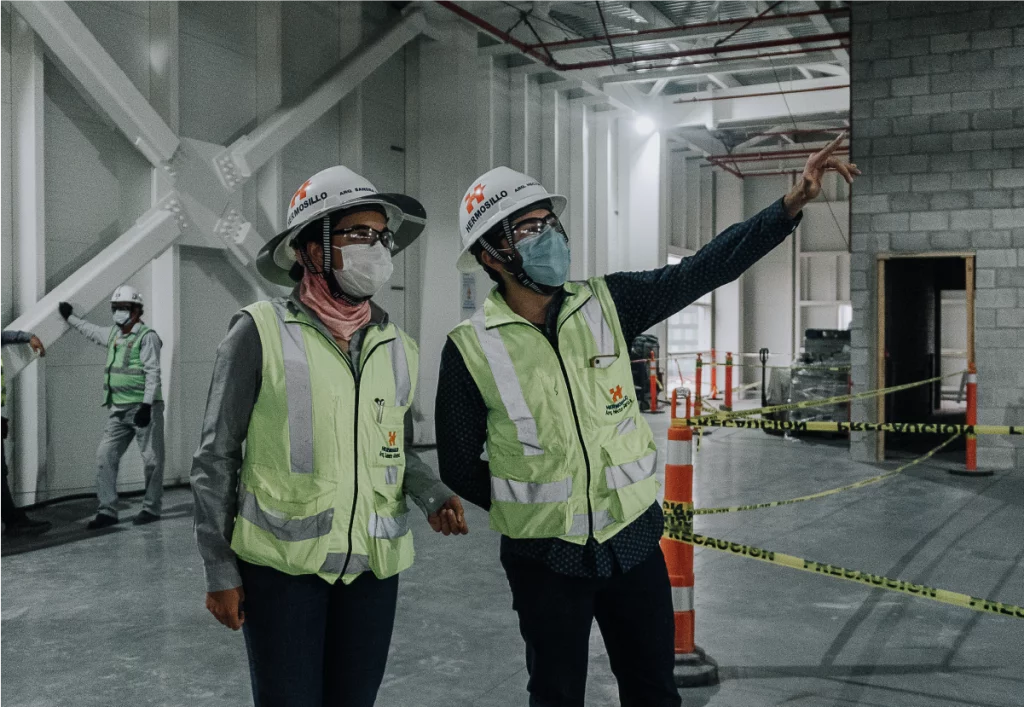
Introduction
In the dynamic world of construction, where heavy machinery, potential hazards, and a wide range of high-risk activities are involved, a culture of safety protocols is mandatory to protect construction workers and minimize the risk of injury.
At Hermosillo, safety is embedded in every aspect of our operations. We aim to reduce incidents, accidents, injuries, and fatalities by prioritizing construction site safety and fostering a safer work environment. This way, we create a strong safety culture where our collaborators feel protected, enhancing productivity and leading to a successful project.
In this blog post, we share practical steps to create a safe working environment for employees and subcontractors and how we foster a positive safety culture of mindfulness on every job site. Keep reading to learn more.
Types of Hazards in Construction Sites
Construction sites can be inherently hazardous, with many potential risks leading to accidents and injuries if not properly addressed. Some of the common types of hazards found on construction sites include:
- Physical hazards: These include dangers such as falling objects, tripping hazards, working at heights, heavy machinery, and loud noise.
- Biological hazards: Construction sites can expose workers to biological dangers such as mold, bacteria, and viruses.
- Chemical hazards: Exposure to substances such as solvents, paints, adhesives, and fuels can lead to chemical burns, respiratory problems, and other serious health effects.
- Electrical hazards: These risks may include faulty wiring, ungrounded equipment, and the potential for electrocution.
- Other potential risks: Construction sites may also have additional hazards specific to the project, such as confined spaces, working with asbestos or other hazardous materials, working in wet conditions, or working near traffic
By recognizing and addressing these various hazards, implementing proper safety protocols, and providing appropriate training and protective equipment, construction sites can reduce the risk of accidents.
The Importance of Construction Site Safety Protocols
Over the years, the importance of construction safety has become increasingly recognized due to the high risk of injuries on-site. Historical incidents have highlighted the need for proper safety training and the implementation of safety procedures.
At Hermosillo, we recognize that safety isn’t just a checklist of protocols – it is a fundamental part of our identity and culture. We don’t just aim to reduce incidents; our goal is to prevent accidents and ensure that every member of the Hermosillo family, whether it’s an employee or a contractor, returns home safely. This is why we have established a strong safety culture with measures and protocols strictly followed on construction sites to create a safe environment for our employees and subcontractors. This includes providing proper training, enforcing safety rules and standards, risk assessment, and ensuring the use of appropriate protective equipment.

Our Preventive Approach: Creating a Safety Culture
Regarding safety, our approach is being preventive and proactive rather than reactive. We believe in investing in safety without compromising our projects and understand that creating a safe work environment requires continuous improvement and learning from past experiences.
Hermosillo’s safety culture involves establishing shared values, beliefs, attitudes, and norms, prioritizing safety above all else. Creating a positive safety culture begins with effective communication and leadership, where management sets clear expectations for safety and actively promotes safe work practices. By fostering a safety accountability culture, we reduce the risk of accidents, improve productivity, and protect the well-being of our workers.
At Hermosillo, ensuring the safety of every worker is not just a priority; it’s a way of life.
Risk Analysis
Safety begins with understanding and mitigating risks. We conduct thorough risk analyses by activity, emphasizing high-risk tasks such as working at heights, in confined spaces and handling toxic substances. By identifying potential risks in advance, we can effectively implement preventive measures with a hierarchy control.
Personal Protective Equipment
Personal protective equipment (PPE) ensures workplace safety and safety protocols at a construction site. PPE is crucial in protecting workers from potential hazards and reducing the risk of injury or illness. It is a physical barrier between the worker and potential risks, ensuring a safe working environment.
Examples of PPE commonly used in construction sites include:
- Hard hats: Protect the head from falling objects, head injuries, and electrical hazards.
- Safety glasses: Shield the eyes from debris, sparks, and chemicals.
- High visibility vests: Enhance visibility and ensure construction workers are easily identifiable, especially in areas with traffic or moving equipment.
- Protective gloves: Guard the hands against cuts, abrasions, chemicals, and burns.
- Safety steel toe footwear: Protect against slips, falls, punctures, electrical hazards, and the impact of falling objects.
- Respiratory protection: Prevent inhalation of harmful dust, fumes, gasses, or vapors.
- Earplugs or earmuffs: Reduce noise levels and protect against potential hearing damage.
At Hermosillo, we provide high-quality personal protective equipment to every employee who requires it, ensuring they have the proper tools to work safely. We also provide proper training on the correct use and maintenance of PPE to ensure its effectiveness.
Our Customized Safety Manuals for Every Project
STPS (Ministry of Labor and Social Welfare) and OSHA (Occupational Safety and Health Administration) require that all construction companies develop and implement a construction safety manual. Nonetheless, the effectiveness of any construction safety plan depends on how well you manage and maintain it.
At Hermosillo, we create customized safety programs and manuals for every project. These manuals are specifically designed to address the unique risks and hazards associated with each job site, ensuring the highest level of safety. For each project, we meticulously review the client’s safety manual, integrating crucial details into our own. This becomes an EHS (Environmental, Health, and Safety) handbook tailored to the specific needs of each construction site. The workbook includes our company’s EHS standards, local regulations, and customer guidelines. We regularly review and update our safety programs to keep them effective, always looking to exceed the standards.
Training and Education Necessary for Construction Workers
Continuous and proper training and education are essential to ensure safe behaviors in the construction industry. They make it easier for workers to understand and follow safety protocols. It is vital to increase their knowledge of potential hazards, teach them how to prevent accidents and equip them with the necessary skills to respond to emergencies.
At Hermosillo, we ensure our collaborators receive top-notch safety training and are up-to-date with the latest safety practices and protocols. They must be able to spot unsafe conditions, electrical hazards, and hazardous materials, taking appropriate measures to mitigate them and reducing the risk of injuries on the construction site. We encourage employees to report incidents or safety violations involving themselves or others through accessible channels. Continuous communication and training empower them to take an active role in maintaining a safe work environment.
Signage at Construction Sites
Clear and strategically placed signage is an indispensable component of construction safety, pivotal in ensuring safety for workers and the general public. These informative signs are essential because they provide instructions and warnings, helping to prevent accidents.
Proper signage not only guides workers and visitors, ensuring they are aware of restricted areas and safe routes, but it also communicates important safety protocols, such as wearing protective gear or adhering to speed limits for vehicles. Moreover, construction signage helps in emergencies by indicating evacuation routes and the location of first aid stations.


OSHA and STPS Approved Trainers
The OSHA and STPS-approved trainers ensure the safety compliance of all our personnel on the construction site. OSHA is responsible for setting guidelines and enforcing standards to protect the well-being of workers in various industries, including construction.
We adhere to OSHA’s guidelines to protect our workers from potential risks and prevent accidents. An OSHA-authorized trainer, Safety Manager Marjorie Gutiérrez, who reports directly to our CEO, leads our commitment to safety. She ensures that all guidelines and standards are implemented effectively throughout our organization. Click here to get to know her and watch an interview where she speaks about her journey in Hermosillo.
Conclusion
At Hermosillo, safety is not just a priority; it’s at the core of our identity, part of our culture, and a fundamental commitment in all our construction projects. We firmly believe that the best work comes from a safe workplace, emphasizing the importance of safety protocols in the construction industry to protect workers and create a hazard-free environment.
Our focus on workplace health and safety includes proper and continuous training and compliance with industry regulations, resulting in a safe working environment, reduced accidents, increased productivity, and project success. Our goal is not just accident reduction but to improve organization culture with incident prevention, ensuring everyone’s safe return home. We invite you to join us as we continue to set industry standards for safety and make every construction project a testament to its importance, creating a legacy of secure, accident-free spaces.







